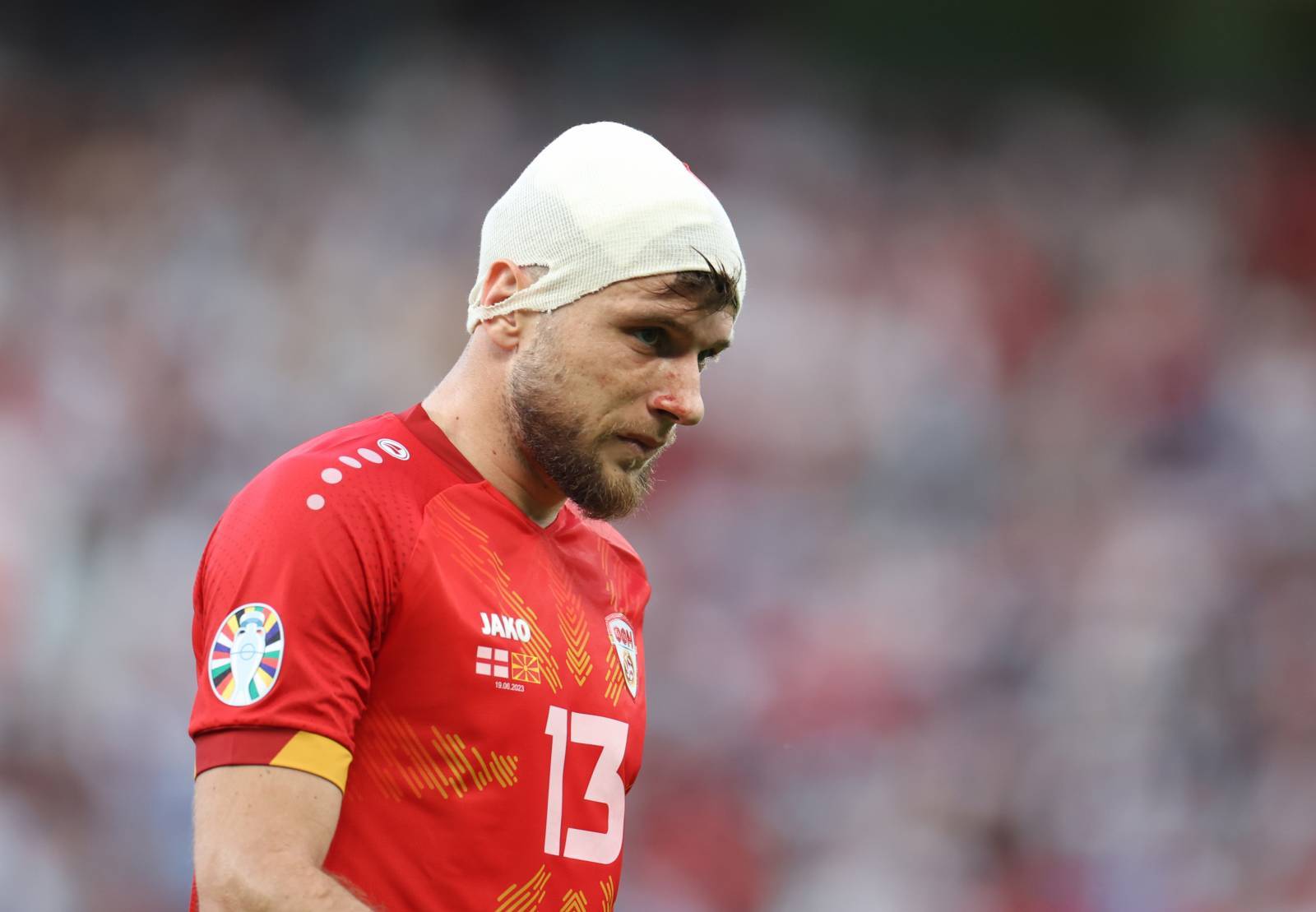MANCHESTER, ENGLAND – JUNE 19: Stefan Ristovski of North Macedonia wearing a bandage on his head following an injury during the UEFA EURO 2024 qualifying round group C match between England and North Macedonia at Old Trafford on June 19, 2023 in Manchester, England. (Catherine Ivill/Getty Images)
A new take on research from the past five years means that the rules of sports may be about to change — and could see players spending more time off the field.
In June, the Concussion in Sports Group (CISG), a network of head injury experts who set the standard for how these injuries are treated in sports, said that repeatedly getting knocked on the head may be “potentially associated” with someone developing an untreatable brain disease, chronic traumatic encephalopathy (CTE).
CTE, which can only be diagnosed after death, is a condition that causes memory loss, changes in personality and violent behaviour. It has mostly been found in people with a history of head injuries.
In the past, experts have looked at whether there could be a link between playing contact sports and the chance of developing brain diseases, such as dementia, Parkinson’s or amyotrophic lateral sclerosis (ALS).
With ALS, the nerves that control how the body’s muscles move start to die, and as with CTE, it gets worse over time. Former South African rugby player Joost van der Westhuizen died of this condition in 2017.
Head injuries in sports have been big news lately. A group of former rugby players — amateur and professional athletes — claim their brain damage is due to injuries from play and are suing World Rugby for not making the rules of the sport safer. Former New Zealand player Carl Hayman, 41, who has been diagnosed with early-onset dementia and probable CTE, is part of the lawsuit.
The sport group’s move marks an about-turn since their previous statement in 2017, in which they said there wasn’t enough evidence to prove the brain disease is caused by frequent hits to the head. The panel of experts maintains in their latest statement that this connection cannot be confirmed, despite public health agencies saying that CTE is caused “in part” by head impacts.
The new document also says that if someone is suspected of having suffered a concussion, they should be examined more thoroughly immediately during the match — which could change the rules of play in some sports.
Need for a time-out
The group advises that a 10 to 15-minute check-up should be done away from the field if a concussion is suspected, said Jon Patricios, a sports medicine physician and one of the authors of the consensus statement at a press recent briefing. If medics think it’s not safe for players to go back to play, they will have to sit out the rest of the game.
Although the rules of professional rugby already allow for players to leave the field to be checked for a concussion, the CISG’s new recommendations could mean that a rule change for soccer is also on the cards.
In this game, play must start again after about three minutes of interruption. If a concussion check longer than this has to be done — as the CISG recommends — a player will have to leave the pitch and their team will have to carry on with one less pair of legs. If players can’t return at all, the game will have to finish with other players in their place.
Having to make a decision in three minutes or taking time to do an off-field assessment while the team is one player down could put pressure on medics to rush an assessment — and potentially miss a symptom of a serious injury.
The International Football Association Board, who makes the laws for soccer, decided in January 2021 to trial a permanent concussion substitute rule. This would allow a team to replace a player suspected of having a concussion without using up one of the three normal subs, which they often use at tactical moments in a game — but the catch is that the player can’t return to the game again at all.
Players want a temporary concussion substitute rule instead. This means that if they’ve had a hard hit on the head, they’d be able to be checked thoroughly — in a quiet area like a changeroom, away from prying eyes. If the medics clear them, they can go back to the game.
After the CISG’s new statement came out, professional soccer players worldwide again asked for this to be considered, saying that it will “protect [their] health and wellbeing”.
But in January, soccer’s rule-making board rejected the idea of temporary concussion substitutes, because, they said, it would increase the chance of misdiagnosis and a player returning to the field, which could make their injury worse. Moreover, they said, “team doctors do not see concussion events very often and cannot be expected to perform a full head-injury assessment at speed”.
Previous research, new understanding
The CISG’s new statement is based on 10 systematic reviews done since 2017. In a systematic review, researchers look at the findings of many studies on the same topic and draw out patterns that hold across all of them. This is why this type of analysis is seen as one of the most reliable forms of evidence in health research.
In one of the reviews, the authors identified 14 813 studies that had something to say about whether concussions and repeated head injuries in sports affect athletes’ brain health later in life. They included only 28 in the end, because the studies had to be of the case–control or cohort type.
In such study designs researchers look at the chance of a condition, like a brain disease, developing in people who are exposed to a certain factor (they’re the “cases”) compared with those who aren’t (they’re the “controls”), or they track a group of people with the same characteristics or experiences — such as playing contact sport and called a cohort — over time.
To understand whether there could be a link between brain disease and repeated head injuries, the factor being investigated was having often received a blow to the head. “Cases” were former athletes — either professional or amateurs — and the “controls” were people who did not play any sports.
The conclusions showed that former professional athletes may have a bigger chance of getting diseases that destroy the nerves that control muscle function later in life, but not amateur-level players.
Yet a prominent study on head impacts and CTE, published last year by a group of researchers led by Chris Nowinski, a neuroscientist and cofounder of the Concussion Legacy Foundation, a United States nonprofit involved in research on concussions and CTE, was not included.
Why was the Nowinski study not considered?
The study didn’t meet their review conditions, says the CISG. For starters, Nowinski and his colleagues did a narrative review, which describes the general context around a research topic from published studies but without choosing them in a very systematic way. Secondly, although Nowinski and his colleagues did look at six case-control studies as part of their paper, they were not designed to measure the risk of the disease, as the CISG was specifically interested in and so they couldn’t be included.
But the CISG says they still need better evidence, including cohort studies, before they can say for sure that repeated head impacts cause CTE. Such studies would need to account for factors such as someone’s level of education, genetics and general health and lifestyle factors such as smoking, high blood pressure or heart disease, which research has shown can affect whether someone develops a brain disease, says Robert Cantu, a co-author of the statement and a professor of neurosurgery at Boston University.
To prove that hard hits to the head cause brain diseases, researchers would also need to know how bad these knocks must be and how many someone must have had, the statement says.
In a study published in the journal Nature Communications in June, scientists examined the brains of 631 former American football players that had been donated to research after their death.
By using data about the force with which a helmet is hit in different player positions in this sport and how long someone played during their life, the researchers could create a model to predict whether an athlete could develop CTE.
The results showed that the more hits to the head someone receives, the worse the brain damage — and that with each extra year someone played, the chance of developing the brain disease rose by 15%.
Will the new views be a game changer?
The CISG says sports in which head injuries are not examined properly should seriously think about making “rule changes in the interest of player welfare”.
This story was produced by the Bhekisisa Centre for Health Journalism. Sign up for the newsletter.





















Discussion about this post